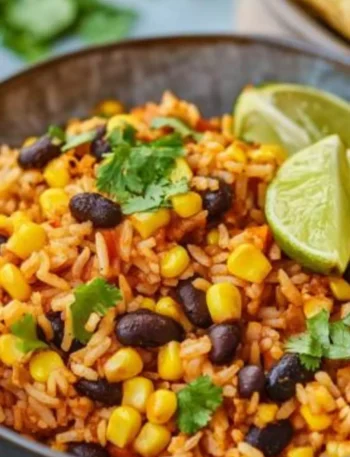As the cooler months roll in and the leaves change color, I find myself gravitating toward hearty meals that warm the soul. One dish that has won my heart is vegetable beef stew. Trust me; there’s something incredibly comforting about a bowl of tender beef and vibrant vegetables simmered together, creating a dish that’s as nourishing as it is delicious.
Before we dive into the delightful details of this stew, let’s talk about what you can enjoy with it. Pair it with some crusty bread for dipping, or serve it alongside a simple salad to balance out the rich flavors. A glass of red wine wouldn’t hurt, either! Perhaps a lovely Cabernet Sauvignon would complement the stew’s hearty notes perfectly.
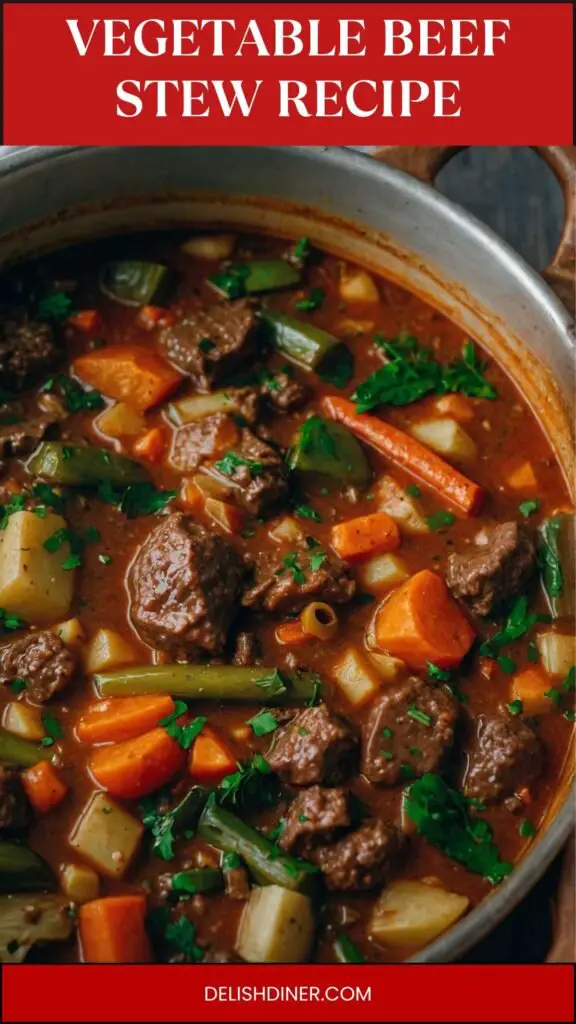
There’s a magic to cooking that often goes unnoticed. It’s not just about mixing ingredients; it’s about building layers of flavor, creating warmth, and, most importantly, evoking memories. When I make vegetable beef stew, I think of chilly evenings spent with family gathered around the kitchen table. The scents wafting through my home invite everyone in, creating an atmosphere of comfort and companionship. It’s a dish that I can make in batches and savor over several days, always improving in flavor.
So what’s the deal with vegetable beef stew? Let’s break it down together.
What is Vegetable Beef Stew?
Vegetable beef stew is a savory dish that combines tender chunks of beef, a colorful assortment of vegetables, and a rich broth that takes your taste buds on a delightful trip. While many people might associate stew with a winter meal, I believe it’s perfect any time you’re in the mood for comfort food. It’s not just food; it’s an experience.
The dish usually includes base ingredients like beef broth, root vegetables, and herbs. It’s a versatile meal that can adapt to whatever you have on hand. Even better? It’s great for meal prep, making it an ideal option for busy weeks.
You will also like the following Lunch and Dinner recipes!
- Taco Stuffed Shells Recipe
- 3 Ingredient Orange Chicken with Orange Marmalade
- How to make Pickled Jalapenos In Chili
Why You’ll Love This Vegetable Beef Stew
This stew has a spread of delicious flavors and textures. Each ingredient plays its part, contributing to the overall enjoyment of the dish. Let me highlight what makes this vegetable beef stew so special:
1. Flavorful Components: The beef absorbs the broth’s flavors while becoming melt-in-your-mouth tender. Toss in earthy root vegetables, and you have a bowl brimming with flavor.
2. Balanced Nutrition: Packed with vegetables and protein, this stew is a wholesome meal. It provides a good mix of carbohydrates, vitamins, and minerals that can help you power through your day.
3. Hearty and Filling: There’s no need for a side dish when this stew takes center stage. It’s satisfying enough to serve as a stand-alone meal.
4. Versatility: You can certainly switch up ingredients. Don’t like green beans? Leave them out. Onions not your thing? No problem! This dish is forgiving.
5. Make Ahead Friendly: It stores excellently in the fridge or freezer. You can whip up a massive pot and enjoy it for days.
The Ingredients You Will Need To Make Vegetable Beef Stew
When you gather your ingredients, ensure you have a mix of fresh and pantry staples. Here’s what you’ll need:
- 2 tablespoons unsalted butter: Adds richness.
- 1/2 large yellow onion, finely chopped: Offers a sweet base.
- 1/2 teaspoon coarsely ground black pepper: For a gentle kick.
- 1 teaspoon dried thyme: Adds warmth.
- 1 cup green peas, frozen: For color and sweetness.
- 4 cups low-sodium beef broth: The heart of the stew.
- 1 cup sweet corn kernels, fresh or frozen: Adds sweetness.
- 2 tablespoons of neutral oil (like canola): For searing the beef.
- 1 bay leaf: Imparts earthy notes.
- 1 teaspoon kosher salt: To elevate flavor.
- 2 tablespoons all-purpose flour: To thicken the stew.
- 1 tablespoon Worcestershire sauce: Adds depth.
- 4 cloves garlic, minced: Brings robust notes.
- 1 cup trimmed green beans, fresh or frozen: Adds a crunchy texture.
- 3 pounds chuck roast, diced into 2-inch cubes: The star protein.
- 2 Yukon Gold potatoes, cubed: For a creamy texture.
- 1/2 teaspoon dried rosemary: Complements the beef.
- 2 large carrots, chopped into 2-inch chunks: Adds natural sweetness.
- 1/4 cup tomato paste: Provides umami and acidity.
- 1 teaspoon smoked paprika: A hint of smokiness.
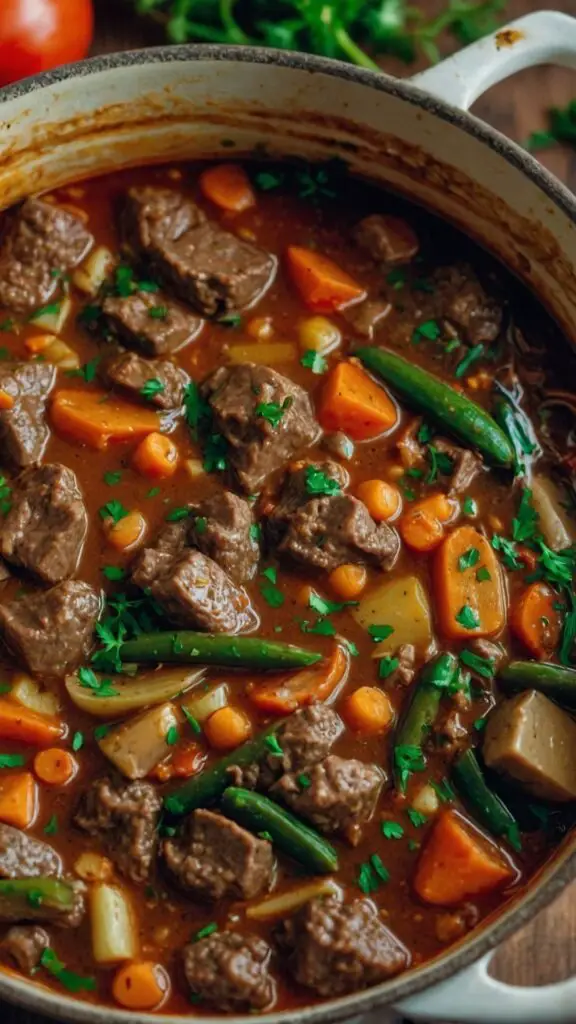
Directions
Step 1: Sear the Beef
In a large, heavy-bottomed pot, heat the oil over medium heat. Once it’s nice and hot, add the beef cubes in batches. Sear them until they are browned on all sides. This step builds flavor that will permeate the entire stew. Remove the beef and set it aside.
Step 2: Sauté the Vegetables
In the same pot, add the butter and let it melt. Toss in the onions and garlic, sautéing until they become translucent and fragrant. Add the carrots and green beans next, stirring them around for a couple of minutes.
Step 3: Add the Flour and Broth
Sprinkle the flour over the sautéed vegetables, mixing well to ensure they are coated. Slowly pour in the beef broth, scraping up any browned bits from the bottom. This adds even more flavors. Add in the Worcestershire sauce, bay leaf, thyme, rosemary, salt, and pepper. Stir everything together.
Step 4: Incorporate the Beef and Veggies
Return the beef to the pot. Add the potatoes, corn, and peas. Stir to combine all the ingredients. Bring the mixture to a gentle simmer.
Step 5: Simmer and Cook
Lower the heat and cover the pot. Let the stew simmer for at least 1.5 to 2 hours. This slow cooking allows the flavors to meld beautifully, and the beef to become tender.
Step 6: Adjust Seasoning and Serve
After the cooking time, taste the stew and adjust the seasoning if necessary. Remove the bay leaf before serving. Ladle into bowls, and enjoy!
Notes
Here are some expert tips that I’ve gathered over the years to make your vegetable beef stew even better:
Don’t Rush the Browning: Give the beef time to develop a nice crust. This adds significant flavor.
Use Fresh Herbs: If you have fresh thyme or rosemary, use them for an aromatic punch. Simply double the quantity when substituting dried herbs.
Don’t Skip the Flour: Dusting the beef in flour before browning helps thicken the stew later.
Vegetable Variations: Feel free to swap in your favorite veggies. Zucchini or parsnips can work wonders in this stew.
Longer Simmering: If you have the time, let the stew simmer longer. The flavors deepen beautifully.
Storage Tips
Vegetable beef stew stores well. Here’s how to keep it fresh:
Refrigeration: Store leftover stew in an airtight container for up to four days in the fridge.
Freezing: If you want to keep it longer, freeze the stew in a freezer-safe container for up to three months.
Reheating: Reheat gently over low heat on the stove, stirring occasionally. Add a splash of broth to bring it back to life.
Nutrition Information
Here’s a breakdown of the approximate nutrition per serving (considering about 8 servings):
Of course, these values depend on exact ingredient ratios and cooking methods.
Serving Suggestions
Here are five tasty ways to enjoy your vegetable beef stew:
1. Serve with Crusty Bread: You can’t go wrong with a warm loaf of crusty bread. It’s perfect for dipping!
2. Add a Side Salad: A simple mixed greens salad with a lemon vinaigrette can balance the heartiness of the stew.
3. Pair with Rice or Quinoa: Scoop the stew over a bed of rice or fluffy quinoa for an additional grain component.
4. Top with Fresh Herbs: Sprinkle freshly chopped parsley or dill on top for a fresh finish.
5. Enjoy with a Glass of Red Wine: The warmth of a good red wine nicely complements the flavors of the stew.
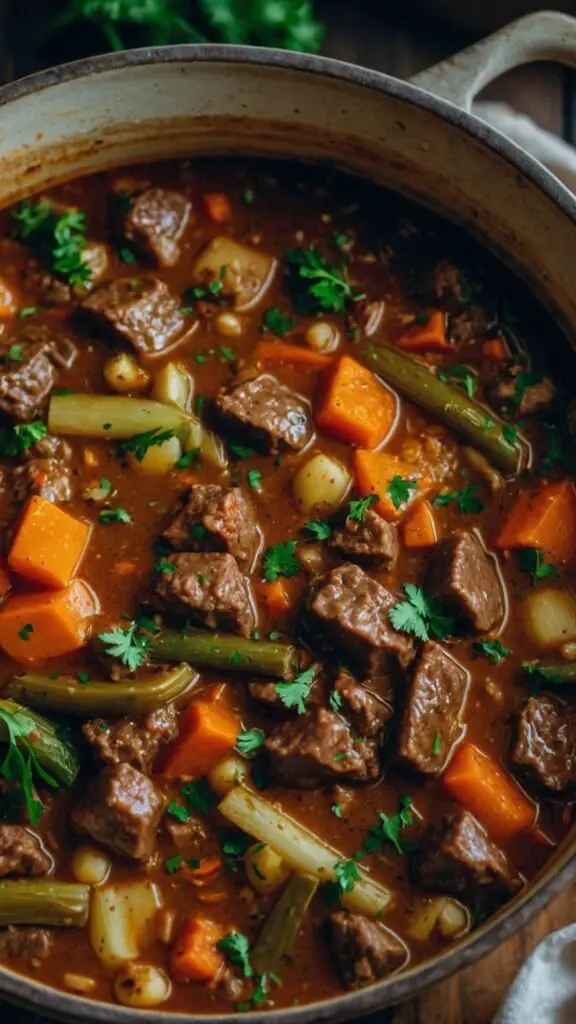
What Other Substitutes Can I Use in Vegetable Beef Stew?
Don’t have something on hand? No problem! Here are some substitutes you can use:
1. Beef: Got chicken or turkey? These can stand in for beef in this recipe. Just reduce the cooking time.
2. Broth: If you only have vegetable broth, go ahead and use it! The flavor will change slightly but still be delicious.
3. Flour: For a gluten-free option, use a gluten-free flour blend to thicken the stew.
4. Vegetables: Almost any root vegetable will work. Think sweet potatoes or turnips.
5. Spices: If you lack smoked paprika, regular paprika or chili powder can be a flavorful alternative.
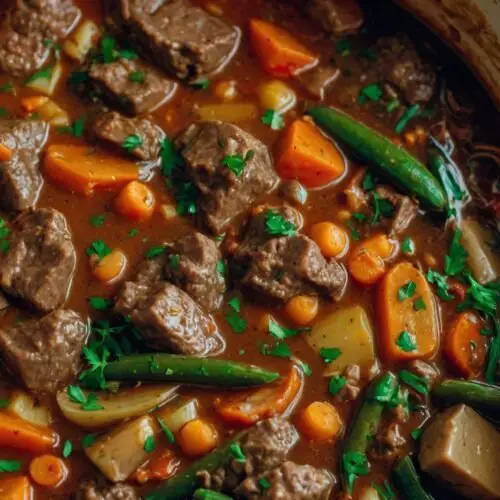
Vegetable Beef Stew Recipe
Equipment
- A pre-heated oven
- large dutch oven
Ingredients
- 2 tablespoons unsalted butter
- 1/2 large yellow onion finely chopped.
- 1/2 teaspoon coarsely ground black pepper
- 1 teaspoon dried thyme
- 1 cup green peas frozen
- 4 cups low-sodium beef broth
- 1 cup sweet corn kernels
- 2 tablespoons of neutral oil
- 1 bay leaf
- 1 teaspoon kosher salt
- 2 tablespoons all-purpose flour
- 1 tablespoon Worcestershire sauce
- 4 cloves garlic minced
- 1 cup trimmed green beans fresh or frozen
- 3 pounds chuck roast diced into 2-inch cubes
- 2 Yukon Gold potatoes cubed
- 1/2 teaspoon dried rosemary
- 2 large carrots chopped into 2-inch chunks
- 1/4 cup tomato paste
- 1 teaspoon smoked paprika
Instructions
Step 1: Sear the Beef
- In a large, heavy-bottomed pot, heat the oil over medium heat. Once it’s nice and hot, add the beef cubes in batches. Sear them until they are browned on all sides. This step builds flavor that will permeate the entire stew. Remove the beef and set it aside.
Step 2: Sauté the Vegetables
- In the same pot, add the butter and let it melt. Toss in the onions and garlic, sautéing until they become translucent and fragrant. Add the carrots and green beans next, stirring them around for a couple of minutes.
Step 3: Add the Flour and Broth
- Sprinkle the flour over the sautéed vegetables, mixing well to ensure they are coated. Slowly pour in the beef broth, scraping up any browned bits from the bottom. This adds even more flavors. Add in the Worcestershire sauce, bay leaf, thyme, rosemary, salt, and pepper. Stir everything together.
Step 4: Incorporate the Beef and Veggies
- Return the beef to the pot. Add the potatoes, corn, and peas. Stir to combine all the ingredients. Bring the mixture to a gentle simmer.
Step 5: Simmer and Cook
- Lower the heat and cover the pot. Let the stew simmer for at least 1.5 to 2 hours. This slow cooking allows the flavors to meld beautifully, and the beef to become tender.
Step 6: Adjust Seasoning and Serve
- After the cooking time, taste the stew and adjust the seasoning if necessary. Remove the bay leaf before serving. Ladle into bowls, and enjoy!
Notes
Nutrition
Frequently Asked Questions
Q1: Can I make vegetable beef stew in a slow cooker?
Absolutely! Brown the beef and sauté the onions first, then transfer everything to your slow cooker. Cook on low for about 6-8 hours or until the beef is tender.
Q2: What can I serve as a side dish with vegetable beef stew?
Classic pairings include garlic bread, a Caesar salad, or even mashed potatoes. It goes well with anything that complements a hearty meal.
Q3: How do I know when the beef is tender?
Gently pulling the meat apart with a fork is an excellent way to check for tenderness. If it shreds easily, it’s done!
Q4: Can I include legumes in my stew?
Yes! Beans or lentils can be excellent additions. Just be sure to adjust the cooking time, as legumes may cook faster or slower.
Q5: How can I make this stew spicier?
Add a pinch of red pepper flakes during cooking or toss in a diced jalapeño for a kick. Spice is all about personal preference!
Q6: Is vegetable beef stew healthy?
While it’s hearty, it’s also packed with protein and nutrients from various vegetables. If you watch the salt and fat content, it can fit well into a balanced diet.
Conclusion
Vegetable beef stew is more than just a meal; it’s a heartfelt experience shared over warm bowls on cold days. You can create a dish that is not only comforting but also nourishes the body and soul. Armed with the right ingredients, some simple steps, and a sprinkle of love, you too can whip up this classic dish.
So why not gather your loved ones, make a big pot, and enjoy the moments? Food, after all, winds its way into our memories and traditions. Happy cooking!


